We are continuing the publication of Thierry Meyssan’s new book, «Before Our Very Eyes, Fake Wars and Big Lies : From 9/11 to Donald Trump». In this episode, he describes the creation of an Egyptian secret society, the Muslim Brotherhood, and then its re-creation after the Second World War by the British secret services. Finally, the use of the group by MI6 to carry out political assassinations in this ex-Crown colony.
The “Arab Spring” as experienced
by the Muslim Brotherhood
In 1951, building on the foundations of the old organisation of the same name, the Anglo-Saxon secret services put together a secret political society called the Muslim Brotherhood. At first they used it to assassinate personalities who resisted them, and then, starting in 1979, as mercenaries against the Soviets. At the beginning of the 1990’s, they incorporated the Brotherhood into NATO, and in 2010, attempted to force it into power in the Arab countries. The Muslim Brotherhood and the Sufi Order of the Naqshbandi were financed with at least $80 billion annually by the ruling Saudi family, which made them one of the most powerful armies in the world. All jihadist leaders, including the leaders of Daesh, belong to this military structure.
The Egyptian Muslim Brotherhood
Four empires disappeared during the First World War – the German Reich, the Austro-Hungarian Empire, the Tsarist Holy Russian Empire, and the Ottoman Sublime Porte. The victors utterly lacked any sense of reason in the conditions they imposed on the defeated. Thus, in Europe, the Treaty of Versailles determined conditions which were unacceptable and unbearable for Germany, falsely blamed as the sole responsible for the conflict. In the Orient, the carving up of the Ottoman Caliphate was not going well. At the San Remo Conference (1920), in accordance with the secret Sykes-Picot agreements (1916), the United Kingdom was authorised to set up a Jewish homeland in Palestine, while France was allowed to colonise Syria (which included, at the time, what is now Lebanon). However, in what was left of the Ottoman Empire, Mustafa Kemal led a revolt both against the Sultan, who had lost the war, and against the Western powers, who were taking control of his country. At the Sèvres Conference (1920), the Caliphate was chopped into little pieces in order to create a variety of new states, including a Kurdistan. The Turko-Mongol population of the provinces of Thrace and Anatolia rose up and carried Kemal to power. Finally, the Lausanne Conference (1923) traced the frontiers we know today, gave up on the idea of Kurdistan, and organised gigantic population transfers which caused more than half a million deaths.
But just as in Germany, Adolf Hitler was to contest his country’s lot, so, in the Near East, a man stood up against the new division of the region. An Egyptian schoolteacher founded a movement to re-establish the Caliphate which the Westerners had defeated. This man was Hassan al-Banna, and his organisation was the Muslim Brotherhood (1928).
In principle, the Caliph was the successor of the Prophet, to whom all owe obedience – it was therefore a very coveted title. There had been several great lines of Caliphs in succession – the Omeyyads, the Abbassids, the Fatimids and the Ottomans. The next Caliph would have to be the man who seized the title – and as it happened, this was the “General Guide” of the Brotherhood, who was quite comfortable with the idea of becoming the master of the Muslim world.
The secret society spread rapidly. Its intention was to work from within the system in order to re-establish Islamic institutions. Applicants had to swear fealty to the founder not only upon the Qu’ran, but also on a sabre or a revolver. The aim of the Brotherhood was exclusively political, even though it expressed itself in religious terms. Hassan al-Banna and his successors never spoke about Islam as a religion, nor did they evoke Muslim spirituality. For them, Islam is no more than a dogma, a submission to God and the exercise of Power. Obviously, the Egyptians who supported the Brotherhood did not see it this way. They followed it because it claimed to follow God.
For Hassan al-Banna, the legitimacy of a government was not to be measured by its representativeness, the way we evaluate that of Western governments, but by its capacity to defend the “Islamic way of life”, in other words, the way of life of 19th century Ottoman Egypt. The Brotherhood never considered that Islam has a History, and that Muslim ways of life vary considerably according to region and era. Neither did it imagine that the Prophet had revolutionised the Bedouin society in which he lived, or that the way of life described in the Qu’ran is no more than a stage meant for those particular men. For them, the disciplinary rules of the Qu’ran – Sharia – do not correspond to a given situation, but fix inalterable laws upon which Power can rely.
For the Brotherhood, the fact that the Muslim way of life had often been imposed by the sword justified the use of force. The Brotherhood would never admit that Islam may have been spread by example. This did not prevent al-Banna and his Brothers from standing for election – and losing. If they condemned political parties, it was not because of opposition to the multi-party system, but because by separating religion from politics, they would succumb to corruption.
The doctrine of the Muslim Brotherhood was the ideology of “political Islam” – “Islamism” – a word which was destined to become all the rage.
In 1936, Hassan al-Banna wrote to Egyptian Prime Minister Mostafa El-Nahas Pasha. He demanded:
![]() legislative reform, and the conformity of all tribunals with Sharia law;
legislative reform, and the conformity of all tribunals with Sharia law;
![]() recruitment within the armies to create a volunteer force under the banner of jihad;
recruitment within the armies to create a volunteer force under the banner of jihad;
![]() connection between all Muslim countries, and the preparation for the restoration of the Caliphate, in realization of the unity demanded by Islam.
connection between all Muslim countries, and the preparation for the restoration of the Caliphate, in realization of the unity demanded by Islam.
During the Second World War, the Brotherhood declared itself to be neutral. In reality, it mutated into an Intelligence service for the Reich. But from the point at which the United States entered the war, when the fortune of arms seemed to be changing sides, it played a double game, and sold information about Germany to the British. In this way, the Brotherhood revealed its total absence of principles and pure political opportunism.
On 24 February 1945, the Brothers tried their luck and assassinated the Egyptian Prime Minister in the middle of a parliamentary session. This was followed by an escalation of violence – a movement of repression against the Brotherhood, and a series of political assassinations, going as far as the murder of the new Prime Minister on 28 December 1948, and in retaliation, the killing of Hassan al-Banna himself, on 12 February 1949. A short time afterwards, a tribunal instituted by martial law condemned most of the Brotherhood to prison sentences, and dissolved their association.
This secret organisation was in reality no more than a band of assassins who hoped to grab power by masking their ambition behind the Qu’ran. Its story should have ended there. Unfortunately, it did not.
The Brotherhood reinstated by the Anglo-Saxons,
and the separate peace with Israel
The capacity of the Brotherhood to mobilise people and turn them into assassins obviously intrigued the major Powers.
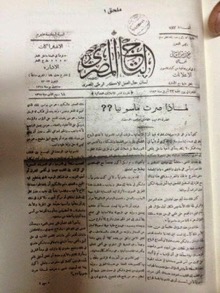
- Despite his denials, Sayyid Qutb was a Freemason. He published an article entitled « Why I became a Freemason », published in the magazine al-Taj al-Masri (the « Crown of Egypt »), on 23 April 1943.
Two and a half years after its dissolution, a new organisation was formed by the Anglo-Saxons, who re-used the name “Muslim Brotherhood”. Because all its historical leaders were incarcerated, ex-judge Hassan al-Hudaybi was selected as General Guide. Contrary to what is often believed, he represented no historical continuity between the old and the new Brotherhood. It transpired that a unit of the old secret society, the “Secret Section”, had been tasked by Hassan al-Banna with perpetrating attacks for which he denied all responsibility. This organisation within the organisation was so secret that it had not been affected by the dissolution of the Brotherhood, and was now available to his successor. The Guide decided to disown the “Secret Section”, and declared that he wanted to attain his objectives only by peaceful means. It is difficult to establish exactly what happened at that moment between the Anglo-Saxons, who wanted to recreate the old society, and the Guide, who believed he was simply reviving its audience from within the masses. In any case, the “Secret Section” survived, and the authority of the Guide waned in favor of other Brotherhood leaders, triggering a great internecine struggle. The CIA gave Sayyid Qutb a leadership position within the Brotherhood. Qutb, a Freemason [1], was the theoretician of jihad, whom the Guide Hudaybi had condemned, before being forced to come to terms with MI6.
It is impossible to specify the relations and degrees of hierarchy between these men, on one hand because each foreign branch enjoyed its own autonomy, and on the other, because the secret units within the organisation no longer necessarily answered either to the General Guide, or the local Guide, but sometimes directly to the CIA and MI6.
During the period following the Second World War, the British attempted to re-organise the world in order to keep it out of Soviet hands. In September 1946, in Zurich, Winston Churchill launched the idea of the United States of Europe. On the same principle, he also launched the Arab League. In both cases, the aim was to unify these regions without Russia. From the beginning of the Cold War, the United States, for their part, created associations tasked with accompanying this movement for their own profit – the American Committee on United Europe and the American Friends of the Middle East [2]. In the Arab world, the CIA organised two coups d’état, first of all in favour of General Hosni Zaim in Damascus (March 1949), then with the Free Officers in Cairo (July 1952). The goal was to support the nationalists who were believed to be hostile to the Communists. It was in this state of mind that Washington sent SS General Otto Skorzeny to Egypt, and Nazi General Fazlollah Zahedi to Iran, accompanied by hundreds of ex-Gestapo officers, with whom they hoped to direct the anti-Communist conflict.
Unfortunately, Skorzeny schooled the Egyptian police in a tradition of violence. In 1963, he chose the CIA and the Mossad over Nasser. As for Zahedi, he created the SAVAK, the cruelest political police force of the time.
While Hassan al-Banna had defined the objective – seizing power by manipulating religion – Sayyid Qutb defined the means – jihad. Once the adepts had admitted the supremacy of the Qu’ran, it could be used as a foundation for organising them into an army and sending them into combat. Qutb developed a Manichean theory which distinguished “Islamist” from “evil”. This brainwashing enabled the CIA and MI6 to use adepts to control the nationalist Arab governments, then to destabilise the Muslim regions of the Soviet Union. The Brotherhood became an inexhaustible reservoir of terrorists under the slogan – “Allah is our goal. The Prophet is our leader. The Qu’ran is our law. The jihad is our way. Martyrdom is our vow”.
Qutb’s ideas were rational, but not reasonable. He applied an ironclad rhetoric of Allah – Prophet – Qu’ran – Jihad – Martyrdom, which left no room for any discussion at any point. He placed the superiority of his logic over human reason.
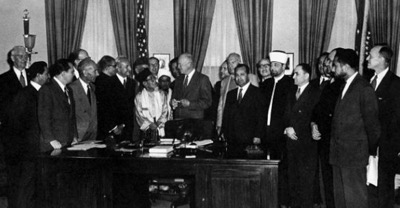
- Reception of a delegation of the secret society by President Eisenhower at the White House (23 September 1953).
The CIA organised a conference at Princeton University on “The Situation of Muslims in the Soviet Union”. It was the occasion for the United States to receive a delegation of the Muslim Brotherhood led by Sa’id Ramadan, one of the heads of its armed branch. In his report, the CIA officer in charge of the summary noted that Ramadan was not a religious extremist, but rather resembled a fascist – a way of underlining the exclusively political character of the Muslim Brotherhood. The conference ended with a reception at the White House, hosted by President Eisenhower, on 23 September 1953. The alliance between Washington and jihadism was formed.
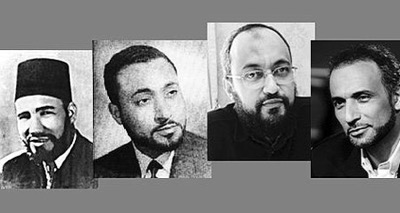
- (From left to right) Hassan el-Banna married his daughter to Saïd Ramadan, which made Ramadan his successor. The couple gave birth to Hani (Director of the Islamic Centre in Geneva) and Tariq Ramadan (who became a full professor with the chair of contemporary Islamic studies at the University of Oxford).
The CIA, which had resuscitated the Brotherhood to use against the Communists, first of all used it to help nationalists. At that time, the Agency was represented in the Middle East by middle-class anti-Zionists. They were rapidly ousted and replaced by senior civil servants of Anglo-Saxon and Puritan origin, graduates from major universities, all favourable to Israel. Now Washington entered into conflict with the nationalists, and the CIA turned the Brotherhood against them.

- Said Ramadan and Abdul Ala Mawdudi hosted a weekly broadcast on Radio Pakistan, a station created by the British MI6.
Sa’id Ramadan had commanded a few combatants from the Brotherhood during the brief war against Israel in 1948, then helped Sayyid Abul Ala Maududi to create the paramilitary organisation Jamaat-i-Islami in Pakistan. The point was to fabricate an Islamic identity for the Muslim Indians so that they could constitute a new state, Pakistan. Jamaat-i-Islami in fact drew up the Pakistani constitution. Ramadan married the daughter of Hassan al-Banna, and became the head of the armed branch of the new “Muslim Brotherhood”.
Meanwhile, in Egypt, the Brotherhood had taken part in the coup d’état by General Mohammed Naguib’s Free Officers – Sayyid Qutb was their liaison officer. They were tasked with eliminating one of their leaders, Gamal Abdel Nasser, who had opposed Naguib. Not only did they fail, on 26 October 1954, but Nasser took power, subdued the Brotherhood, and put Naguib under house arrest. Sayyid Qutb would be hanged a few years later.
Forbidden in Egypt, the Brotherhood fell back to the Wahhabi states (Saudi Arabia, Qatar and the Emirate of Sharjah), and to Europe (Germany, France and the United Kingdom, plus neutral Switzerland). Each time, they were received as Western agents fighting the growing alliance between the Arab nationalists and the Soviet Union. Sa’id Ramadan was issued a Jordanian diplomatic passport, and settled in Geneva in 1958. From there that he directed the destabilisation of the Caucasus and Central Asia (both Pakistan-Afghanistan and the Soviet Fergana Valley). He took control of the Committee for the construction of a mosque in Munich, which enabled him to supervise almost all the Muslims in Western Europe. With the assistance of the American Committee for the Liberation of the Peoples of Russia (AmComLib), which is to say the CIA, he had at his command Radio Liberty /Radio Free Europe, a radio station financed directly by the US Congress to spread the philosophy of the Brotherhood [3].
After the Suez Canal crisis and the spectacular about-face of Nasser to join the Soviets, Washington decided to provide unlimited help to the Muslim Brotherhood in the fight against the Arab nationalists. A senior officer of the CIA, Miles Copeland, was charged – in vain – with selecting a personality within the Brotherhood who could play, in the Arab world, a role equivalent to that of Pastor Billy Graham in the United States. It was not until the 1980’s that a preacher of that calibre was found – the Egyptian Yusuf al-Qaradawi.
In 1961, the Brotherhood established a connection with another secret society, the Order of the Naqshbandis. This was a sort of Muslim Freemasonry which mixed Sufi initiation with politics. One of their Indian theorists, Abu al-Hasan Ali al-Nadwi, published an article in the Brotherhood’s magazine. The Order is ancient, and represented in many countries. In Iraq, the grand master was none other than the future vice-President, Izzat Ibrahim al-Douri. He would support the attempted coup d’état by the Brotherhood in Syria, in 1982, and then the “Return to Faith Campaign” organised by President Saddam Hussein in order to restore an identity to his country after the imposition of the Western no-fly zone.
In Turkey, the Order would play a more complex role. It would include as its directors both Fethullah Gülen (founder of the Hizmet movement) and President Turgut Özal (1989-1993), as well as Prime Minister Necmettin Erbakan (1996-1997), founder of the Justice Party (1961) and the Millî Görüş movement (1969). In Afghanistan, ex-President Sibghatullah Mojaddedi (1992) was the Order’s grand master. In 19th century Russia, with the help of the Ottoman Empire, the Order had raised up Crimea, Uzbekistan, Chechnya and Daghestan against the Tsar. Until the fall of the USSR, we would hear nothing more of this branch – just as in the Chinese Xinjiang region. The proximity between the Brotherhood and the Naqshbandis is very rarely studied, given the a priori Islamist opposition to mysticism and Sufi orders in general.
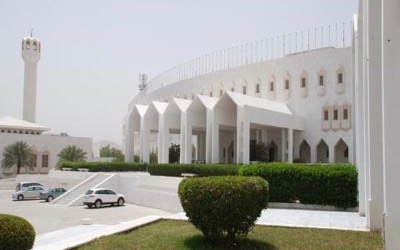
- The Saudi headquarters of the World Islamic League. In 2015, its budget was superior to that of the Saudi Ministry of Defence. The world’s major buyer of weapons, Saudi Arabia acquired arms which the League distributed to the organisations of the Muslim Brotherhood and the Naqshbandis.
In 1962, the CIA encouraged Saudi Arabia to create the Muslim World League and finance both the Brotherhood and the Naqshbandi Order to work against the nationalists and the Communists [4]. The organisation was first of all financed by Aramco (Arabian-American Oil Company). Amongst the twenty or so founding members, we note the presence of three Islamist theorists whom we have already mentioned – the Egyptian Sa’id Ramadan, the Pakistani Sayyid Abul Ala Maududi, and the Indian Abu al-Hasan Ali al-Nadwi.
De facto, Arabia, which suddenly disposed of enormous liquidities thanks to the commerce in oil, became the godfather of the Muslim Brotherhood all over the world. At home, the monarchy entrusted them with the educational system for schools and universities, in a country where almost no one knew how to read or write. The Brotherhood had to adapt to its hosts. Indeed, their allegiance to the King prevented them from swearing loyalty to the General Guide. In any case, they organised around Mohamed Qutb, Sayyid’s brother, in two tendencies – the Saudi Brotherhood on one side, and the “Sururists” (adepts of Sheikh Surur) on the other. The Sururists, who are Saudis, attempted to create a synthesis between the Brotherhood’s political ideology and Wahhabi theology. This cult, of which the royal family are members, lived by an interpretation of Islam which was born of the Bedouin tradition, iconoclast and anti-historic. Until Riyadh came into all its petro-dollars, it made traditional Muslim schools anathema, which, in return, considered it heretical.
In reality, the politics of the Brotherhood and the Wahhabist religion have nothing in common, although they are compatible – except that the pact linking the Saud family with the Wahhabist preachers cannot exist within the Brotherhood – the idea of a “divine right” monarchy clashes with the Brotherhood’s greed for power. It was therefore agreed that the Sauds would support the Brotherhood everywhere in the world, on the condition that they abstain from entering politics in Arabia.
The Saudi Wahhabi support for the Brotherhood provoked extra rivalry between Arabia and the two other Wahhabi states – Qatar and the Emirate of Sharjah.
From 1962 to 1970, the Muslim Brotherhood took part in the civil war in North Yemen, and attempted to re-enlist the monarchy on the side of Saudi Arabia and the United Kingdom against the Arab nationalists, Egypt and the USSR – a conflict which foreshadowed what was to happen over the next half-century.
In 1970, Gamal Abdel Nasser managed to negotiate an agreement between the Palestinian factions and King Hussein of Jordan, which put an end to the “Black September” terrorist group. But on the evening of the Arab League summit which met to ratify the agreement, he died, officially from a heart attack, but was far more probably assassinated. Nasser had three vice-Presidents – one from the left wing who was extremely popular; a centrist, a very public figure; and a conservative at the bidding of the United States and Saudi Arabia – Anwar el-Sadat. Under pressure, the left-wing vice-President declared himself unfit for the function. The centrist vice-President preferred to abandon politics. Sadat was therefore designated as the Nasserian candidate. This drama is played out in many countries – the President chooses a vice-President from among his rivals in order to extend his electoral base, but when he dies, the vice-President replaces him and ruins his heritage.
Sadat, who had served the Reich during the Second World War, and professed great admiration for the Führer, was an ultra-conservative soldier who served as Sayyid Qutb’s alter-ego, a liaison officer between the Brotherhood and the Free Officers Movement, the group of nationalist authors who instigated the 1952 revolution in Egypt. As soon as Sadat gained power, he freed the Muslim Brothers who had been imprisoned by Nasser. The “faithful President” was the Brotherhood’s ally for anything concerning the Islamisation of society (the “Corrective Revolution”), but its rival when politically profitable for him. This ambiguous relationship was illustrated by the creation of three armed groups, which were not factions within the Brotherhood, but exterior units under its orders – the Islamic Party of Liberation, the Islamic Jihad (under Sheikh Omar Abdul Rahman), and Excommunication and Immigration (the “Takfiri”). All of them claimed to be following the instructions of Sayyid Qutb. Armed by the secret services, the Islamic Jihad launched attacks against the Coptic Christians. Far from mitigating the situation, the “faithful President” accused the Copts of sedition, and imprisoned their Pope and eight of their bishops. Finally, Sadat intervened in the government of the Brotherhood and took a stance in favor of the Islamic Jihad against the General Guide, whom he arrested [5].
On instructions from US Secretary of State Henry Kissinger, Sadat convinced Syria to join with Egypt to attack Israel and restore Palestinian rights. On 6 October 1973, while the Israelis were celebrating Yom Kippur, the two armies took the Hebrew country in a pincer movement. The Egyptian army crossed the Suez Canal, while the Syrian army attacked from the Golan Heights. However, Sadat only partially deployed his anti-aircraft cover, and halted his army 15 kilometres to the East of the Canal – meanwhile, the Israelis attacked the Syrians, who discovered that they were trapped and screamed conspiracy.
It was only when the Israeli reserve forces had been mobilised, and the Syrian army was surrounded by Israeli troops, that Sadat ordered his army to continue its progression, before halting it once again to negotiate a cease-fire. Observing the Egyptian treason, the Soviets, who had already lost an ally with the death of Nasser, threatened the United States and demanded an immediate cessation of combat.
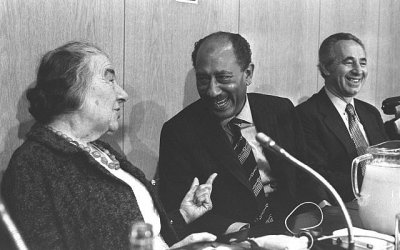
- Ex-liaison officer with Sayyid Qutb for the « Free Officers » and the Brotherhood, the « believer president », Anouar el-Sadate, was to be proclaimed as the « sixth caliph » by the Egyptian parliament. Here, this admirer of Adolf Hitler is in the Knesset alongside his partners Golda Meïr and Shimon Peres.
Four years later – still pursuing the CIA plan – President Sadat went to Jerusalem and signed a separate peace treaty with Israel, to the detriment of the Palestinians and of Syria. From then on, the alliance between the Muslim Brotherhood and Israel was sealed. All the Arab peoples decried this treason, and Egypt was excluded from the Arab League, whose headquarters were moved to Algiers.
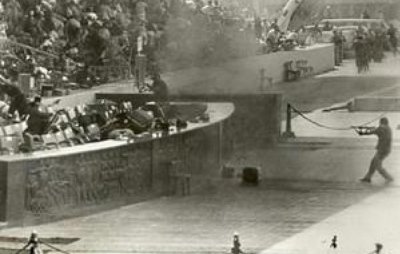
- Responsible for the « Secret Wing » of the Muslim Brotherhood, Ayman al-Zawahiri (currently the head of Al-Qaïda) organised the assassination of President Sadate (6 October 1981).
In 1981, Washington decided to turn the page. The Islamic Jihad was ordered to eliminate Sadat, who had outlived his usefulness. He was assassinated during a military parade, while the Parliament was preparing to proclaim him the “Sixth Caliph”. In the presidential box, seven people were killed and 28 wounded, yet sitting next to the President, his vice-President General Mubarak survived. He was the only person in the box wearing body armour. He succeeded the “faithful President”, and the Arab League could now be repatriated to Cairo.
https://www.voltairenet.org/article206934.html
 TheAltWorld
TheAltWorld 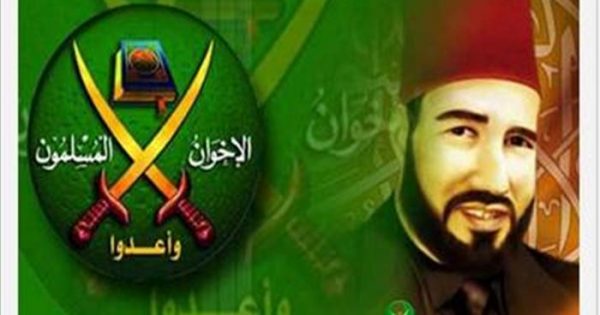

0 thoughts on “The Muslim Brotherhood as assassins-2”